 W
WAmblyomma variegatum, commonly known as the tropical bont tick, is a species of tick of the genus Amblyomma endemic to Africa. It has spread from its centre of origin to several countries, including the Caribbean islands, where it is known as the Senegalese tick and the Antigua gold tick. They are vividly coloured and have a substantial impact on livestock, primarily through their transmission of diseases. They are three-host hard ticks that have been found on a variety of domesticated species such camels, cattle, goats, sheep, dogs, and various species of wildlife.
 W
WThe cat flea is an extremely common parasitic insect whose principal host is the domestic cat, although a high proportion of the fleas found on dogs also belong to this species. This is despite the widespread existence of a separate and well-established "dog" flea, Ctenocephalides canis.
 W
WCephenemyia trompe, also known as the reindeer nose botfly, is a species of botfly first described by Adolph Modéer in 1786. It belongs to the deer botflygenus Cephenemyia. This fly is parasitic on reindeer. It is one of two Cephenemyia species found only in Scandinavia.
 W
WCheyletiella is a genus of mites that live on the skin surface of dogs, cats, and rabbits.
 W
WCochliomyia hominivorax, the New World screw-worm fly, or screw-worm for short, is a species of parasitic fly that is well known for the way in which its larvae (maggots) eat the living tissue of warm-blooded animals. It is present in the New World tropics. There are five species of Cochliomyia but only one species of screw-worm fly in the genus; there is also a single Old World species in a different genus. Infestation of a live vertebrate animal by a maggot is technically called myiasis. While the maggots of many fly species eat dead flesh, and may occasionally infest an old and putrid wound, screw-worm maggots are unusual because they attack healthy tissue.
 W
WCulicoides is a genus of biting midges in the family Ceratopogonidae. There are over 1000 species in the genus, which is divided into many subgenera. Several species are known to be vectors of various diseases and parasites which can affect animals. Like Leptoconops, the genus has a long fossil record, with earliest known fossils being from the Burmese amber, around 99 million years old.
 W
WCulicoides imicola is a species of Ceratopogonidae that transmits the bluetongue virus (BTV) and the African horse sickness virus. This particular species has been recorded in Africa, Asia and Europe. African midges feed on animal blood, including horse, cattle, and sheep. Unlike other species within the Culicoides genus, this species prefers drier habitats for egg laying but retains a preference for moist soil to support larvae growth. Other suspected BTV vectors are Culicoides (Culicoides) pulicaris and species in the Culicoides (Avaritia) obsoletus complex.
 W
WThe Culicoidini is a tribe of biting midges.
 W
WDermanyssus gallinae is a haematophagous ectoparasite of poultry. It has been implicated as a vector of several major pathogenic diseases. Despite its common names, it has a wide range of hosts including several species of wild birds and mammals, including humans. In both size and appearance, it resembles the northern fowl mite, Ornithonyssus sylviarum.
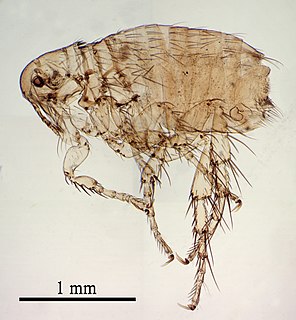 W
WThe dog flea is a species of flea that lives as an ectoparasite on a wide variety of mammals, particularly the domestic dog and cat. It closely resembles the cat flea, Ctenocephalides felis, which can live on a wider range of animals and is generally more prevalent worldwide.
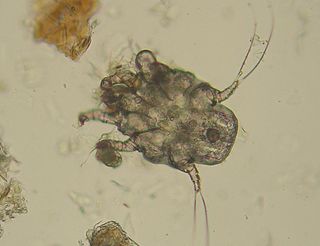 W
WEar mites are mites that live in the ears of animals and humans. The most commonly seen species in veterinary medicine is Otodectes cynotis. This species, despite its name, is also responsible for 90% of ear mite infections in cats.
 W
WEchidnophaga gallinacea, commonly known as the hen flea, stickfast flea and sticktight flea, occurs on a wide range of bird and mammal hosts. If uncontrolled it causes anaemia, loss of condition, severe skin irritation and sometimes death.
 W
WFlea, the common name for the order Siphonaptera, includes 2,500 species of small flightless insects that survive as external parasites of mammals and birds. Fleas live by consuming blood, or hematophagy, from their hosts. Adult fleas grow to about 3 millimetres long, are usually brown, and have bodies that are "flattened" sideways or narrow, enabling them to move through their host's fur or feathers. They lack wings, but have strong claws preventing them from being dislodged, mouthparts adapted for piercing skin and sucking blood, and hind legs extremely well adapted for jumping. They are able to leap a distance of some 50 times their body length, a feat second only to jumps made by another group of insects, the superfamily of froghoppers. Flea larvae are worm-like with no limbs; they have chewing mouthparts and feed on organic debris left on their host's skin.
 W
WThe Gasterophilus, commonly known as botfly, is a parasitic fly from the family Oestridae that affects different types of animals, especially horses, but it can also act on cows, sheep, goats and, even, it has been recorded a case in a human baby.
 W
WHaematobia irritans, the horn fly, is a small fly. It was first described by Carl Linnaeus in his 1758 10th edition of Systema Naturae. It is of the genus Haematobia which is the European genus of bloodsucking flies. Haematobia irritans is a native of Europe but has been introduced to North America and is considered a potentially dangerous livestock pest.
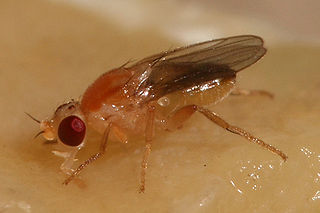 W
WHippelates is a genus of flies in the family Chloropidae and are often referred to as eye gnats or eye flies.
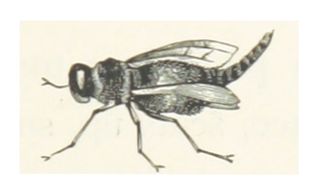 W
WHypoderma tarandi, also known as the reindeer warble fly and reindeer botfly, is a species of warble fly that is parasitic on reindeer.
 W
WMange is a type of skin disease caused by parasitic mites. Because mites also infect plants, birds, and reptiles, the term "mange" or colloquially "the mange", suggesting poor condition of the hairy coat due to the infection, is sometimes reserved only for pathological mite-infestation of nonhuman mammals. Thus, mange includes mite-associated skin disease in domestic animals, in livestock, and in wild animals. Since mites belong to the arachnid subclass Acari, another term for mite infestation is acariasis.
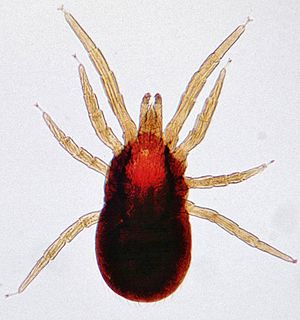 W
WMites are small crawling animals related to ticks and spiders. Most mites are free-living and harmless. Other mites are parasitic, and those that infest livestock animals cause many diseases that are widespread, reduce production and profit for farmers, and are expensive to control.
 W
WMusca autumnalis, the face fly or autumn housefly, is a pest of cattle and horses.
 W
WMyiasis is the parasitic infestation of the body of a live animal by fly larvae (maggots) which grow inside the host while feeding on its tissue. Although flies are most commonly attracted to open wounds and urine- or feces-soaked fur, some species can create an infestation even on unbroken skin and have been known to use moist soil and non-myiatic flies as vector agents for their parasitic larvae.
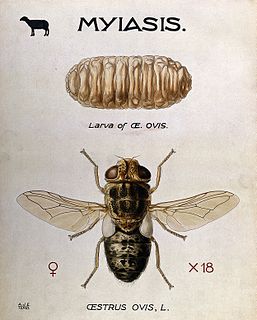 W
WOestrus ovis, the sheep bot fly, is a widespread species of fly of the genus Oestrus. It is known for its parasitic predation and damage to sheep, deer, goats and sometimes cattle. There have also been many records of horse, dog and human infestation. In some areas of the world it is a significant pest which affects the agricultural economy.
 W
WOrnithonyssus sylviarum is a haematophagous ectoparasite of poultry. In both size and appearance, it resembles the red mite, Dermanyssus gallinae.
 W
WPsoroptes is a genus of mites, including the agents that cause psoroptic mange.
 W
WStomoxys calcitrans is commonly called the stable fly, barn fly, biting house fly, dog fly, or power mower fly. Unlike most members of the family Muscidae, Stomoxys calcitrans and others of its genus suck blood from mammals. Now found worldwide, the species is considered to be of Eurasian origin.
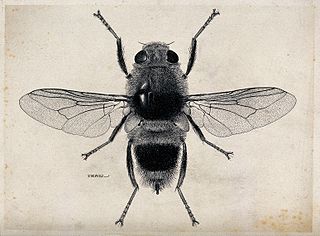 W
WWarble fly is a name given to the genus Hypoderma, large flies which are parasitic on cattle and deer. Other names include "heel flies", "bomb flies" and "gadflies", while their larvae are often called "cattle grubs" or "wolves." Common species of warble fly include Hypoderma bovis and Hypoderma lineatum and Hypoderma tarandi. Larvae of Hypoderma species also have been reported in horses, sheep, goats and humans. They have also been found on smaller mammals such as dogs, cats, squirrels, voles and rabbits.